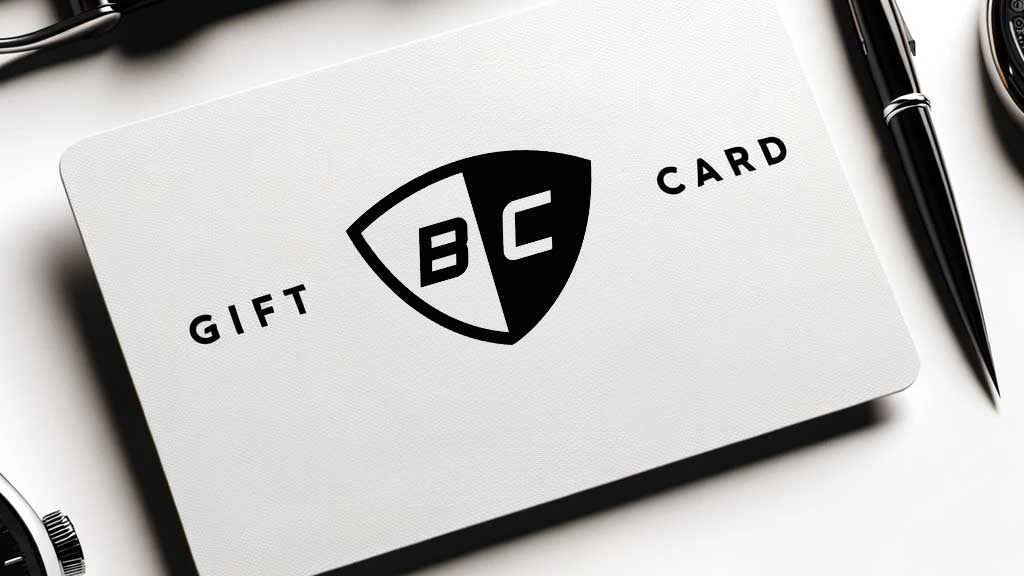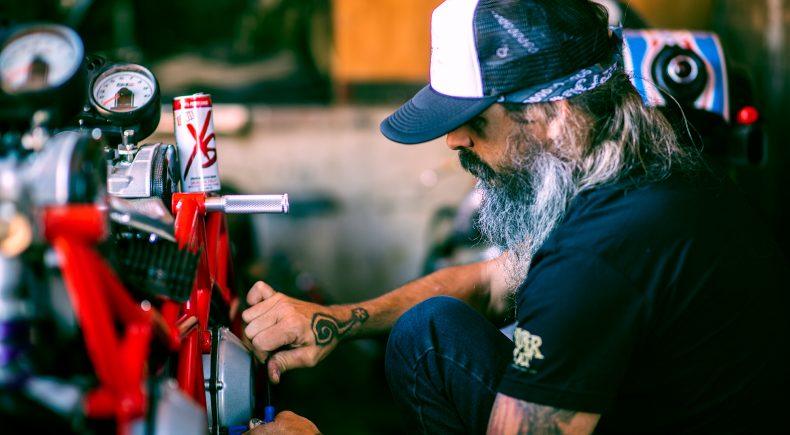
Jared Johnson is the founder of Holiday Customs, a custom motorcycle shop in Portland, OR. His work has been featured in Pipeburn, and is well recognized for his sense of creativity and innovation. He was invited by Thor Drake of See See Motorcycles to put his latest custom motorcycle on display at the 2016 One Moto Show in Portland, OR.
British Customs: How did Holiday Customs get started?
Jared Johnson: In 2009 I moved from Lake Tahoe, California to Portland, Oregon to pursue my passion for snowboarding, which I was doing professionally. At that point, I had been snowboarding for 14 years. Five days after I moved there though I broke my back pretty severely in a snowboarding incident. After that happened I needed to figure out a new way to make money, so I started talking to my friends to get some ideas. They said I was handy and good at wrenching, and told me to put a listing up on Craigslist and see what happened. So once I was walking again I restored some old bikes, put out a listing, and ended up actually selling them. I was making decent enough money rebuilding and selling bikes that I decided to wanted to do it for a living, and I opened Holiday Customs in 2010 after I built and sold several bikes.
BC: How did you get started welding and machining?
JJ: I grew up Northern California, where my family had some property. The nearest town was 45 minutes away, so we were far enough out that when something broke we had to figure out a way to fix it ourselves. I have to hand the majority of the responsibility to my dad though: he was always a car and motorcycle guy, and we had a full shop in the garage. And out back behind the garage we had this big heap of metal and parts that my dad had collected over the years, so whenever we had an idea and we wanted to make something, we would go through the heap and look for things to make our projects from. He let me and my brother use the welder so we could get weird and make whatever we wanted. I remember my dad once made a go kart with wheelbarrow tires on the front, car tires in the back, a Fiat tranny, and it was powered by an engine we pulled from a Honda CB400. I have the same blood as my dad though, and that same will to get weird with metal and wheels.

I have the same blood as my dad though, and that same will to get weird with metal and wheels.
BC: What does it mean to you to be able to create things with your hands?
JJ: It means a lot. I feed off of it. Sometimes I come into the shop and I’m not really feeling lit, but as soon as I chop into some metal to make something I feel like I’m doing something with my hands and I get and excited and then I’m there for 10 hours. I’m a bit of an anxious person, and I have to be able to do something or work on something; it makes my day feel complete. It means a lot to me to be able to make something out of nothing. Riding makes me feel complete too. Wrenching and riding are like two halves of the same whole.
BC: Your builds feature innovative uses of materials like wood and cork, and the curves of your frame almost make it look organic. What is your design philosophy when you approach a build?
JJ: I was inspired by a Schwinn bicycle I once built, actually. I bought a Schwinn beach cruiser and modified it and jammed an XR70 motor in it and I loved it. When I wanted to start making custom motorcycles, I noticed I never saw bikes with curvy frames or parts. After I sketched one out I thought it would work. So I built it and people loved it, so I launched a series of bikes based off of it. I take stock XS650s, keep the front half of the frame, lop off the tail end, and roll metal to make the tail section I want. So many parts on a bike are round — like the wheels and the headlights — and so I wanted the whole bike to have that look.

Wrenching and riding are like two halves of the same whole.
BC: What got you into vintage bikes then?
JJ: I’ve always been into restoring things. When I was a kid, I had a Red Flyer Wagon, and I remember taking the wheels off and repainting them because I wanted to give the wagon new life. Whenever I’m around an older motorcycle, I think about the history and where it’s been, and I want to give it a second or even a fifteenth chance at life. They put more time into old iron. Vintage bikes just look so cool. And they’re hard to start, and they’re grumpy and leaky, but the design just looks so…hard, and tough, and sexy. I’m not sure if I’ll look back on the engines of this era and think they’re sexy or not. They just don’t build things like they used to.
BC: Where do you think the custom motorcycle scene is going?
JJ: I think the trend that’s going on right now of buying a crappy bike online and making a custom bike out of it really got started started in ’09 or ’10. The price of bikes on Craigslist have skyrocketed, and everyone thinks they’re a garage builder — which is totally fine, but it’s just made everything much more expensive. It’s going to peak at some point. I think people are getting tired of having their butt beat riding around on a chopper that looks good but has no function, and I think the new trend will be making custom dual sports that can be ridden around town and also taken onto the dirt.

BC: Many of the pictures I’ve seen of you are from motorcycle camping trips.
JJ: My upbringing was full of camping. And I’m still a country boy. Back in 2012 some friends came up with the idea to load up some bikes and go on a four-day camping trip from Portland to Idaho, following dirt roads the whole way. It was so memorable: the thrill of getting lost; overcoming obstacles like bikes breaking down, crashing, falling in five foot-deep puddles we thought were just, well, puddles; the sense of adventure. I live for those times. When I got back the first time after living off the back of a motorcycle, I saw all the stuff I owned and I felt like it was all nuts and that everything I needed was on that motorcycle. Except for my French press.
BC: What kind of bike did you use on that trip?
JJ: I used a street legal ’86 XL600 the first time, and it was great. She handled it beautifully. Some of the other trips I made were on a 2005 Husqvarna 450.

Whenever I’m around an older motorcycle, I think about the history and where it’s been, and I want to give it a second or even a fifteenth chance at life.
BC: Do you have any preferences as to what kind of bike you like to work on?
JJ: Air-cooled carbureted bikes, definitely. I like to keep the ignition components stock, because I’ve seen too many people who upgraded their stator and other electronics and it was always a nightmare. I’ve never had a problem with stock ignition setups — they’re always the most reliable.
BC: What bike are you going to be showing at The One Show?
JJ: One of my curvy, Schwinn-inspired framed bikes. I put multiple tanks on it before I found one that was all beat up and had deep rust on the outside of the tank, but the inside was fine. I put a 21 inch front wheel I pulled from a Honda on the front, and put a rusty black Harley front headlight on there. I made the fork tubes for the front end myself, and tried to emulate the way the old Triumphs looked with it. It also has a cable pulley brake system. I spent a lot of time on the pipes, too: they’re the focal point of the build. When I was designing the bike I had the idea to make an X-pipe, and after I had the idea I couldn’t not do it, even though I thought it was a bad idea initially. But it turned out awesome. The bike looks very well-used, and I love it.





Leave a comment
All comments are moderated before being published.
This site is protected by reCAPTCHA and the Google Privacy Policy and Terms of Service apply.